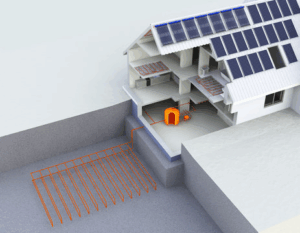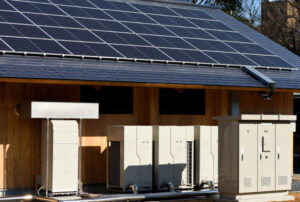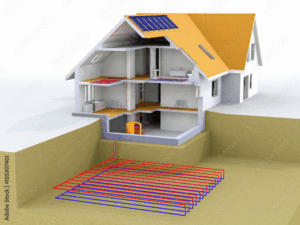When it comes to heating and cooling solutions for your business, the choices can feel overwhelming. From traditional HVAC systems to the latest in sustainable technology, there are plenty of options out there. Two of the most talked-about systems today are air-source heat pumps vs. geothermal heat pumps (ASHPs and GHPs). But how do you decide which is the right fit for your business? Let’s break it down and help you make an informed decision.
What Are Air-Source Heat Pumps (ASHPs)?
Air-source heat pumps are like nature’s way of recycling heat. They transfer heat from the air outside to warm your building in winter and reverse the process to cool it in summer. Think of it as a two-way street for temperature control – efficient and versatile.
How Do ASHPs Work?
Picture a refrigerator, but for your entire building. ASHPs use refrigerant and a compressor to move heat in and out of your space. Even in cold weather, there’s heat in the air (yes, really!), and these pumps extract it to keep things cozy.
Advantages of ASHPs
- Lower upfront costs: Compared to geothermal systems, ASHPs are generally more budget-friendly to install.
- Easy installation: Since they don’t require underground components, installation is quicker and simpler.
- Energy efficiency: Modern ASHPs are incredibly efficient, especially in moderate climates.
- Dual functionality: They provide both heating and cooling, saving you from investing in separate systems.
Limitations of ASHPs
- Performance in extreme cold: In freezing climates, ASHPs can struggle to extract enough heat, leading to higher energy use or inability to function below 10 degrees C.
- Lifespan: They usually have a shorter lifespan compared to geothermal systems.
- Noise: Outdoor units can be a bit noisy, which might be a concern for certain businesses.
What Are Geothermal Heat Pumps (GHPs)?
Geothermal heat pumps, also known as ground-source heat pumps, tap into the consistent temperature of the earth to heat and cool your space. Think of it as harnessing the power of Mother Earth for your business.
How Do GHPs Work?
Imagine a series of pipes buried underground, circulating a liquid that absorbs and releases heat. This closed-loop system connects to your building’s heat pump, creating an efficient heating and cooling cycle.
Advantages of GHPs
- Energy efficiency: Geothermal systems are some of the most efficient HVAC solutions available, saving you money on energy bills.
- Longevity: The underground loop systems can last 50+ years, while the indoor components typically last 20-25 years.
- Consistency: Unlike ASHPs, geothermal systems aren’t affected by outdoor temperatures and can operate at any weather extremes.
- Environmentally friendly: These systems reduce your carbon footprint by utilizing renewable energy.
Limitations of GHPs
- Higher upfront cost: Installing a geothermal system is a significant investment due to excavation and piping.
- Installation complexity: You’ll need enough land or a suitable site for the underground loops.
- Time-consuming installation: The setup process can take longer compared to ASHPs.
Comparing Costs: Initial Investment vs. Long-Term Savings
Let’s talk numbers because, at the end of the day, your budget matters. ASHPs typically have a lower initial cost, making them an attractive option for businesses with tight budgets. But don’t let the upfront expense of GHPs scare you away – their operating costs are significantly lower, often paying for themselves in savings over time.
For example, if your business is located in a region with high utility costs, the energy efficiency of geothermal systems can lead to substantial long-term savings. On the other hand, if you’re in a mild climate, ASHPs might provide a better balance of cost and performance.
Environmental Impact: Which System Is Greener?
If sustainability is a core value for your business, both systems have eco-friendly benefits. ASHPs reduce reliance on fossil fuels, and modern models use environmentally safe refrigerants. Geothermal systems take it a step further by using the earth’s natural temperature, reducing greenhouse gas emissions significantly.
Want to flaunt your green credentials? A geothermal system might give you an edge in appealing to eco-conscious clients and stakeholders.
Installation and Maintenance: What to Expect
ASHPs
- Installation: Quick and straightforward. A qualified technician can often complete the job in a day or two.
- Maintenance: Regular check-ups are required to keep the system running efficiently, but costs are relatively low.
GHPs
- Installation: More complex and time-intensive due to the need for underground work.
- Maintenance: Minimal once installed. The durable underground loops rarely require attention, but indoor components still need routine servicing.
Which System Is Right for Your Business?
Here’s the million-dollar question. The choice between ASHPs and GHPs ultimately depends on your specific business needs, location, and budget. Let’s break it down further:
- Choose ASHPs if:
- You’re in a moderate climate.
- Budget is a major concern.
- You need a quick and easy installation.
- Choose GHPs if:
- Your business prioritizes long-term savings.
- You have suitable land or space for installation.
- Sustainability is a key value.
Conclusion
Deciding between air-source heat pumps and geothermal systems doesn’t have to be a headache. Both offer energy-efficient, eco-friendly solutions to meet your heating and cooling needs. If you’re looking for something simple and cost-effective, ASHPs might be your go-to. But if you’re ready to invest in a long-term, sustainable option, geothermal could be the perfect fit.Not sure where to start? Reach out to the experts at EnviroTech Geothermal for personalized advice and solutions tailored to your business. After all, the right choice isn’t just about saving money; it’s about creating a comfortable, sustainable environment for your team and clients. Let’s make it happen!


